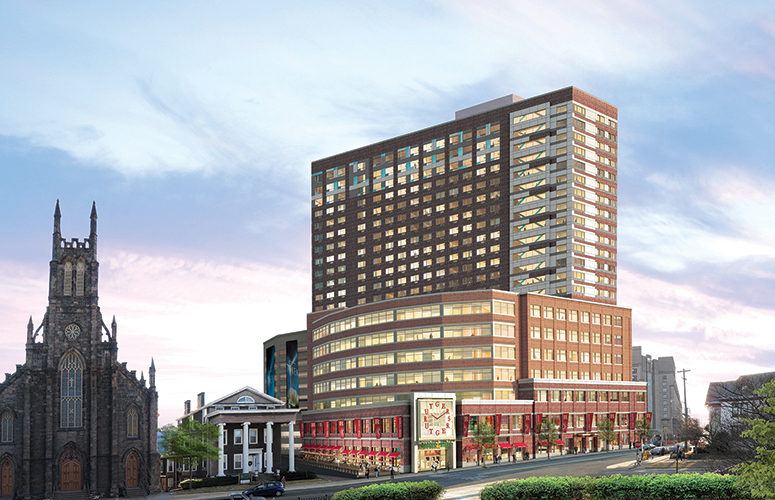
Middlesex County: Focused on the Future
The 322-square-mile region boasts mega healthcare, warehousing, retail, entertainment and transportation projects.
By Larry Feld, Contributing Writer On Jul 3, 2023Middlesex County refers to itself as “the heart” of New Jersey. Located in the center of central New Jersey, the county encompasses 322 square miles, with 25 municipalities and 19 county parks. Its centralized location provides swift access to international airports, major rail lines, and interstate highways, and to one of the world’s largest ports just a few miles away.
According to the 2020 Census, the county has a growing population of 861,418. With a median household income of $99,427, Middlesex County’s population has a median age of 39.5 years. Most important for commercial developers, the county offers a workforce of nearly a half million educated workers on tap (44% with bachelor’s degrees or better).
Middlesex County is home to dozens of major corporations. In Edison alone, there are more than 20 major companies employing more than 1,000 workers. While the healthcare and life sciences industries dominate, the county is also home to a growing list of technology, manufacturing, and food innovation businesses. Powerhouse brands in life sciences such as Johnson & Johnson, Bristol Myers Squibb, and Novo Nordisk are headquartered here. Meanwhile, the state’s most prominent healthcare facilities, including Robert Wood Johnson University Hospital, St. Peters Healthcare System, RWJ Barnabas Health, Raritan Bay Medical Center, and JFK Medical Center all reside in Middlesex County.
Even though these large healthcare systems continue to build satellite locations outside the county, their efforts – such as the recently announced Saint Peter’s Health and Wellness Center in nearby Somerset – appear to ultimately be feeders designed to eventually drive patients back to the “home base” medical centers for care. “Reaching beyond the hospital walls to better serve patients ultimately brings new families into the Saint Peter’s family,” notes Leslie D. Hirsch, president and CEO of Saint Peter’s Healthcare System, adding: “Even so, our primary commitment remains serving the residents of Middlesex County.”
Rehabilitated Sites
Shuttered manufacturing sites from the 1980s are just beginning to be rejuvenated. In Sayreville, the city’s planning board last year approved a plan that will bring 1.78 million square feet of warehouse and office space to the Fulton’s Landing Redevelopment area south of Main Street, on a 156-acre parcel formerly home to the Linden Sand Mining Company.
Another ambitious redevelopment project in Sayreville is the Riverton. After years of planning and rehabilitation, the $2.5 billion Riverton project is transforming a 400-acre former paint manufacturing site into a destination community. The planned 6.5-million-square-foot mixed-use development will stretch along two miles of the Raritan River waterfront. It includes 1.3 million square feet of retail/entertainment space, 2 million square feet of office and other commercial space, as well as 2,000 residential units, 300 of which will be affordable housing units.
North American Properties, the site developer, announced that Bass Pro Shops will break ground this fall on a 198,000-square-foot store, marking the Riverton’s first tenant. “Bass Pro Shops has told us it will be the largest, single-level Bass Pro Shops in the country,” said Kevin Polston, project executive with North American Properties.
In addition to private development, the county government is also investing in economic expansion projects, according to Ronald G. Rios, director of the Board of County Commissioners.
In New Brunswick, for example, construction of the New Jersey Health and Life Science Exchange (HELIX) is underway. Middlesex County, through the Improvement Authority, is providing the financing mechanism for nearly $500 million to construct the first phase of the HELIX, a 573,400-square-foot multipurpose facility that will house the NJ Innovation Hub, a unique creator’s space for start-up businesses as well as research labs for Rutgers. The HELIX will also house the command center for DataCity, the county’s living laboratory for autonomous technology. DataCity is part of the Rutgers Center for Advanced Infrastructure and Transportation (CAIT), a project that will use the New Brunswick streets and highways as a living lab to tackle complex, high-volume infrastructure challenges.
Phase 2 of the HELIX project, announced in late May, will include 600,000 square feet of build-to-suit lab and office space that can accommodate a range of uses for large corporate life sciences and technology company tenants. The final phase of HELIX is proposed as a 42-story mixed-use building to include additional office space and 220 units of housing.
A $750 million facility expansion for cancer treatment is also under construction in New Brunswick. The new Jack and Sheryl Morris Cancer Center, a partnership of the Rutgers Cancer Institute of New Jersey and RWJBarnabas Health, will be a state-of-the-art, freestanding cancer hospital. Scheduled for completion in the fall of 2024, the 12-story, 510,000-square-foot building will offer both outpatient and inpatient capacity as well as provide space for research laboratories, and ancillary services devoted to patient wellness.
Middlesex County is investing $25 million into the center’s development. County Board of Commissioners Director Rios notes that the facility “will transform cancer care through research, education, and patient care. In addition, the Cancer Center will provide academic and hands-on training opportunities for Middlesex College and Middlesex County Magnet Schools students.”
Middlesex College’s access to the cancer center is one example of the county’s efforts to expand the vision of county college education. The college’s leadership team created the CIO Strategic Investment Plan to transform the campus into a multi-faceted regional destination.
Plans include an open-air multipurpose community venue for concerts, cultural events, and sporting events as well as the creation of a workforce development & conference center; a new community park and student center; a destination athletic complex; and the creation of a new Middlesex County Magnet School.
North Brunswick Train Station
After 15 years of planning and discussion, the North Brunswick Train Station project has been greenlighted by the State Legislature with the allocation of $50 million from the New Jersey Transportation Trust Fund. The Middlesex County Improvement Authority (MCIA), tasked with managing the project, has partnered with NJ TRANSIT, and in February 2023, NJ TRANSIT gave the MCIA formal approval for 10% of the design. Middlesex County has also committed $20 million to develop the parking facility for the new train station.
New Brunswick Train Station
A much-needed facelift to the New Brunswick train station was announced last fall. The $49 million project will utilize funds provided by the New Jersey Debt Defeasance and Prevention Fund to renovate and update the existing train station. Upgrades to the structure, which dates back to 1903, include building new passenger platforms, installing new elevators and escalators, replacing the HVAC system, and adding energy-efficient lighting.
“Middlesex County’s future-forward vision and key investments will have a positive impact on our business ecosystem and residents for decades to come,” Rios concludes.
To access more business news, visit NJB News Now.






